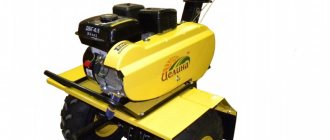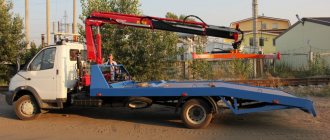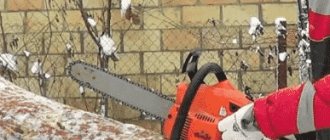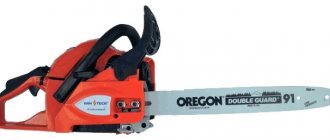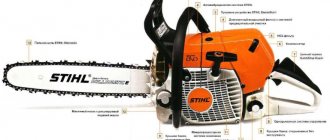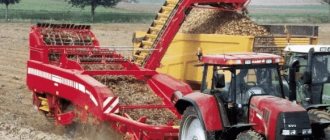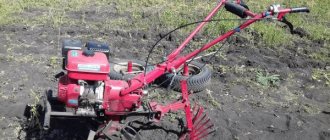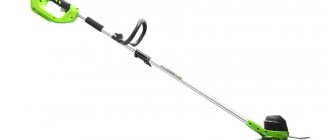What is a wood miter saw?
The miter saw has twin brothers: the pendulum saw, the electric miter box, and the angle cutter.
All these devices have a common design - a swinging arm (pendulum) with a circular saw mounted on it, a frame on which the material being cut rests, and guides along which the material is fed to the saw blade. The simplest option includes only a lever with a saw and a frame; such a tool can only saw off straight ends at right angles.
Wood miter saw
This device is used in procurement areas of production for sawing blanks of the required length from round or square rods, pipes or profiled metal products. For construction and carpentry work, a more advanced mechanism is required. The saw blade can be installed in it at an arbitrary angle in two planes. To do this, the frame is made rotary and equipped with a protractor to accurately measure the angle of rotation, and the lever with the saw attached to it can also rotate around its axis.
Workflow using a miter saw
Thanks to precision manufacturing, robust design, high rotation speed of the electric motor, the use of high-strength tool steel and modern methods of sharpening the disc, the unit provides angular and dimensional accuracy and surface quality unattainable with hand tools.
What is a miter saw for?
This question may seem naive to some, but there is nothing shameful in it.
Trimming machines have long gone beyond carpentry, expanding the boundaries of their use. Therefore, it is quite appropriate to dwell on how this tool is used today. A crosscut saw, also known as a miter saw or pendulum saw, is a machine for cross-cutting long workpieces at the desired angle. The main advantage of the tool is the ability to maintain specified cutting angles with surgical precision. The saw unit rotates right and left, so you can cut workpieces in half strictly at 90° or at any other specified angle. The saw can also be tilted to the side - this allows you to cut the ends straight or with the desired bevel. The settings for transverse and oblique cutting are set on the vertical and horizontal cutting scale. All functions to maintain the specified cutting parameters are performed by mechanics.
This tool is used primarily with wood: cutting boards, timber, lining, laminate, etc. Trimming is indispensable for cutting skirting boards, baguette and cornice profiles and any other sawing work where guarantees of an accurate and tightly fitted miter joint are needed. Models with a cutting depth limiter are convenient for creating carpentry joints - they are used to select grooves and cut tenons.
When installing the appropriate discs, the machine can be used for cutting composite materials, thin-walled pipes and light metal profiles.
Interesting fact!
In 1957, the Italian company Felisatti released its first product catalog, which included, among other things, the world's first portable cross-cutting machine for cutting wood and thin-walled profiles. Thanks to its mobility and functionality, the tool quickly gained recognition, and the brand itself gained authority among power tool manufacturers.
2
Purpose of trimmings
The main purpose of a miter saw follows from its name, and this is exactly what its inventor, Raymond DeVault, used for it. This is sawing off the ends of boards and bars exactly at right angles and exactly to size.
Sawing off the ends of boards
However, modern wood miter saws can not only cut off ends at any vertical and transverse angles. With the use of additional equipment - such as additional guides, stops, programmable broaching systems and others, they can work not only with boards and bars, but also with parts of arbitrary shape, select grooves, and form dovetail joint elements. In addition, they can be used to cut out many elements of connections from the Japanese school of carpentry, in which the assembly of wooden structures is carried out without glue and metal fasteners, only due to the precise fit of the shaped protrusions into their corresponding grooves.
Metal saw
Miter saws for metal are similar to saws for wood, but have significant design differences. Due to the greater specific gravity and greater strength of the sawn material, they are equipped with
- More powerful frames, guides and stops.
- More powerful and high-speed engines.
- Special discs made of high-strength tool steel, including diamond-coated ones.
On metal miter saws, there is also a smaller range of adjustment of the disc installation angles, eliminating bending of the workpiece and pinching of the teeth, and the broaching mechanism has a different design due to the friction properties of the metal being different from those of wood. Actually, they are less common due to the lesser need for shaped processing of the ends of rod and pipe metal products.
A professional miter saw is:
- Miter saw with broach.
- Powerful high-speed engine.
- Disc at least 250 mm in diameter.
- Wide and stable bed with durable adjustable guides.
- Sawdust removal system.
Professional miter saw with broach
It should be understood that even a professional miter saw is a highly specialized tool. It is designed for cross cutting. It will not be possible to unravel the boards on it, even if there is a broach. However, hybrid systems do not have this drawback.
With or without broaching?
To create longer cuts, choose models with a broach, also known as miter-sliders, in which the saw unit not only lowers down and turns to the sides, but also moves in a horizontal plane - forward and backward. In addition to the increased cutting width, broached crosscuts provide a number of additional benefits, such as allowing double cuts to be made in one pass.
Crosscuts without broaching, despite their seeming obsolescence, are no less popular. The ratio of sliders and conventional miter saws on the power tool market is about 60 to 40 - this is a rather rough statistic, which, however, clearly shows that old-type systems are not going to lose their positions.
Limitations in cutting length are compensated by the stability of adjustments and reliability of the system, which are achieved thanks to a simplified design and fewer moving parts. Models without broaching are much lighter - the difference in weight is 25-50% - this is a strong argument if the machine is often moved or transported to different sites. And finally, the price issue, in which everything is obvious - miter saws without broaching cost an order of magnitude less than saws of the same class, but with broaching.
For saws of different classes, discs with different rake angles are used, as we discussed above. For sliders, discs are selected whose teeth have a negative rake angle. For saws without broaching, use blades with a positive angle.
In many slider models, the saw unit moves back and forth along guides that require a minimum of 30-40 cm of free space from the wall. If there is a sawdust bag at the back, you will need even more space. In a small workshop, placing such a trim can be a difficult task.
In modern models, developers have successfully solved this problem. For example, in Boshev's Glide family of crosscut saws, the saw unit moves not along guides, but with the help of a hinge-lever mechanism. Festool uses an even more beautiful engineering solution in its KAPEX KS 60 saws: the guide rods are turned towards the operator and do not protrude beyond the body during broaching.
10
Functions of hybrid models
Hybrid models are saws equipped with an additional work table with longitudinal guides, into which a removable circular saw is attached from below, and the blade goes into a groove on the table.
Hybrid miter saw model
We must be aware that this device will not be able to alternately unravel the boards and process their ends. With each change of operation, you will have to rearrange the saw and change the disk, carry out adjustments and set the initial coordinates.
This option is not acceptable for large volumes of sawing. In this case, it would be more appropriate to purchase two specialized units, each of which will be well-debugged and will be able to work with the proper accuracy and performance.
However, for an amateur craftsman who is not burdened with large production volumes and has limited funds, a hybrid model may be a good solution, especially for the first time.
How to choose the right trimmer
How to choose a miter saw so that
- Don't regret it.
- Don't overpay.
Sales consultants on the sales floor know everything about the products presented to them. However, so that the buying process does not turn into a monotonous monologue of a consultant and the suppressed silence of the buyer, who ends up taking away with him a model twice as powerful and three times more expensive than he could actually afford, the buyer needs to have a clear idea of
- why does he need a saw;
- what operations he plans to perform on it most often;
- what are the maximum dimensions of workpieces;
- what volume of work is planned per month?
Clear answers to these questions, firstly, will inspire the consultant with minimal respect, and, secondly, will allow you to narrow the range of models under consideration to reasonable limits. But even within this narrowed list, the range of prices and additional features will be great. At this stage, the buyer must decide
- does he need a laser pointer (in fact, he always needs it. The time for cutting “by eye” is over.);
- Do you need an electronic adjustment system with memory?
- Is a pulling system needed?
If a miter saw is purchased for occasional work, such as making a frame for a greenhouse or a garden gate, there is no need to splurge on a high-performance professional unit from a well-known brand with an extended base, electronic settings, controlled broaching and other improvements.
Such a saw will be needed if the buyer plans to open his own woodworking business and already has a sufficient volume of orders of medium and high complexity. In this case, a professional device will save time and quickly pay for itself.
Disc diameter and cutting parameters
Some of the most important parameters of the saw are the diameter of the blade and the cutting parameters. In a home workshop, a 250 mm disc with a seat diameter of 30 mm will be completely sufficient. Professional systems are equipped with larger diameter discs, reaching up to half a meter.
Characteristics by disc diameter and cutting parameter
The cutting length in entry-level systems usually does not exceed 150 mm. If you need to cut slab material, you will need a machine with a horizontal movement option and two guides of sufficient length. As a rule, devices of this class are equipped with a drawing system.
The maximum thickness of the material also depends on the class and power of the miter saw; for entry-level systems it is 50 mm, for professional units it reaches up to 150.
Another important parameter is the drive and transmission type. Miter saws are equipped with two types of electric motors - asynchronous or commutator. Asynchronous motors are less noisy and do not require maintenance; commutator motors have an excellent service life, but require maintenance and periodic replacement of brushes.
Torque from the engine axis to the axis of the working disk is also transmitted in two main ways - gear or belt transmission.
Geared Miter Saw
The gear drive ensures reliable operation and does not allow slipping during high loads. However, it is characterized by high noise and vibration at the resonant frequencies of the gearbox.
Belt drive is less noisy. The absence of vibration guarantees stable cutting. Needs periodic adjustment due to belt stretching and loosening.
Design features
The miter saw is structurally not too complicated. The main elements are a cutting head with a cutting disc and a base - a frame with a rotary table. The disc is driven by a motor.
A handle is provided to control the tool. The location of the engine is to the right of the saw blade. There are models in which the disk is located at the rear - this is done to make it more convenient to work with the equipment and to provide better visibility for the operator when he cuts material at an angle.
Now we should dwell on a number of points. The rotation of the saw blade occurs as a result of the engine running and the gearbox being engaged.
There may be two transmissions, each of which has disadvantages and advantages. The toothed structure eliminates the possibility of slipping during operation of the tool. The belt transmits less noise into the surrounding space, and in addition, the disk practically does not vibrate with it.
On the one hand, this preserves the engine, but on the other, the belt itself wears out quite quickly and, being a consumable item, cannot be replaced under warranty. There are models without gearbox. Their torque is low, but the likelihood of failure of such saws is also low due to the minimum of rubbing parts.
The motor itself can be asynchronous or commutator. In the first case, there is less noise during operation of the saw, plus such a motor can work longer under constant operation conditions. As for the second type, such saws require regular maintenance, and most importantly, high torque is their main advantage compared to the first. What type of miter saw to base your choice on must be decided based on the work ahead. It is possible to cut a workpiece at a specific angle only when the base is rotated. Household-grade tools can allow the table to be rotated in one direction, professional ones - in two directions, and this is important if you have to work with workpieces of complex shapes and large sizes.
Typically, the rotation angle is 45º in each direction. It can be 50 and 60º, but in different directions in different ways. The table rotates relative to the guide, which fixes the position of the workpiece on the bed. Thus, parts can be trimmed in any position without reinstalling them.
Professional saws provide the ability to tilt the cutting part of the head. This is required for bevel cuts. Models can be rotated only in one direction or in both directions at an angle of 30, 45, 47º. A small note about this part of the tool: look at the ease of movement of the cutting head; a move that is too tight will require serious physical effort from the operator, which is quite costly during long-term work.
Additional options
Companies that produce end plates compete to provide their products with the maximum number of additional options. Some of these options are aimed at increasing safety, others at increasing productivity and developing new functions, and others at improving working conditions and ease of use.
Lighting the cutting area
Options such as:
- Lighting the cutting area.
- Speed maintenance system.
- Cutting depth limiters, allowing you to make grooves.
- Laser level indicator.
have become a de facto standard and are included in the equipment of almost every model.
Miter saw stand
A useful option at the top of the product line is a sturdy stand onto which the saw is mounted. With this addition, you don’t need to worry about mounting it on a workbench or making a separate desktop
Additional features and security
Almost all modern models are equipped with a lot of additional functionality, which greatly facilitates operation, increases the efficiency, safety of use and the cost of the tool. Before you move on to purchasing a trim saw, you should figure out what functions are necessary to solve the tasks assigned to the tool:
- The dust removal system is a pipe for connecting a vacuum cleaner, an external Cyclone system or a dust collector bag. If only occasional work with the tool is expected, then there is no point in focusing on the dust removal system;
- The protective cover completely covers the saw blade until the workpiece begins to be cut. This is an extremely necessary element of the “trimming”, providing additional safety during operation;
- Depth limitation. This option is necessary if you intend to use a tool to create grooves;
Depth limitation is necessary to create grooves - Illumination of the working area allows you to see the intended cutting location. A very useful option if you plan to use the tool in places with insufficient lighting;
- The laser pointer indicates the location of the cut, which significantly increases the accuracy when processing the material;
- Soft start ensures a gradual increase in the rotation speed of the saw blade. The presence of this option reduces the load on the power system and also prevents the tool from jerking at the moment of start;
- Automatic shutdown when the saw blade jams increases safety when operating the tool;
- Adjusting the number of revolutions of the equipment allows you to select the most suitable mode for obtaining the cleanest cut or higher cutting speed for a certain material;
- Constant speed support allows you to maintain optimal performance regardless of the load on the cutting tool.
What to look for when purchasing
To independently choose a miter saw, you need to formulate the same questions for yourself as for a consultant in a store.
In addition, it is important not to lose sight of the following criteria:
- Purpose of purchasing the tool. For occasional work in the home workshop, you can be satisfied with a locally produced entry-level model with a standard set of options. For professional work with large volumes, you will need a more advanced tool, equipped for those types of work that will be performed most often.
- Work safety. Make sure that the protective cover of the working disk is securely fastened and easily moved, that the power cable is sufficiently long, and that the power button latch operates reliably.
- The weight and dimensions should be within your range and ensure long-term work without fatigue.
- Ergonomics. The saw should be easy to use, fit well in the hand, and not require unnecessary movements or awkward postures when working.
The depth and width of the cut are the key characteristics that determine the list of materials available for cutting on this model and the maximum dimensions of the workpieces processed.
Tips for choosing
As a conclusion, we recommend that you familiarize yourself with the recommendations of professionals on choosing a good trim for your home and garden:
- Pay attention only to models from reliable and trusted manufacturers: Metabo, Bosch, Makita, DeWALT;
- Always pay attention to the cutting width of the selected model. If you have to work with wide workpieces, purchase a tool with a broach;
- For non-professional work, choose household-grade models with a power plant power of 1.5-1.8 kW. This is sufficient for cutting most materials;
- The function of tilting the head left/right will significantly expand the capabilities of the saw. Optimal values are 45°/45°;
- The quality of the cut depends on the speed of rotation of the equipment. Pay attention to models with a value of this parameter of at least 4000 rpm;
- Adjusting the speed allows you to better tailor the sawing process to the characteristics of the material being processed.
And lastly: you shouldn’t skimp on safety. Buy a tool equipped with an electrodynamic brake and automatic shutdown when the disc jams.
Watch a video on how to choose a good miter saw
DIY wood miter saw
It is quite possible to make an entry-level miter saw yourself in a home workshop. To do this, it is enough to have an average level of plumbing and welding skills.
DIY wood miter saw
The following materials and equipment will be required:
- Grinder (it can be removed from the machine and used for its intended purpose).
- The steering axis of the wheel from the car, or king pin.
- Ball bearing 150 mm.
- Two shock absorbers from a truck (with faulty hydraulics, only the mechanical part is needed).
- Corner 30×30.
- Galvanized roofing sheet.
- Fasteners
- Drilling machine.
- Welding machine.
A kingpin is used as the basis of the pendulum device; it is fixed by a bearing. Ears are welded to the bearing for mounting on the frame using screws with a diameter of 6 or 8 mm. To protect the pendulum assembly from chips, a small protective box is made from sheet metal.
The broaching system is made of shock absorbers. To do this, you need to drain the oil from them and make ventilation holes; they should be protected from sawdust with a metal or nylon mesh.
The blade guard can be taken from an old circular saw or bent from tin yourself.
The resulting unit does not look as presentable as factory-produced miter saws, but has good performance characteristics: the disk rotation speed is 4500 rpm, and the cutting length is 350 mm (equal to the shock absorber stroke). You will have to put up with the high noise level of the installation, and to adjust the accuracy of the cuts, you can use a set of backing bars or come up with a more advanced design.
